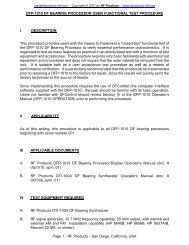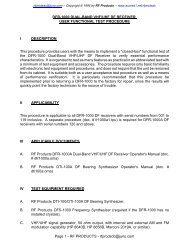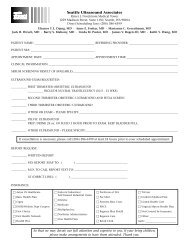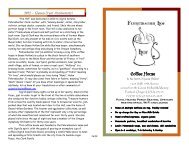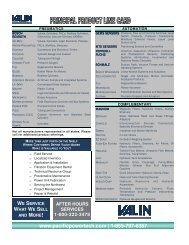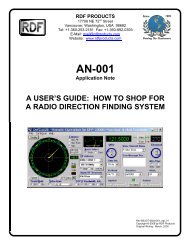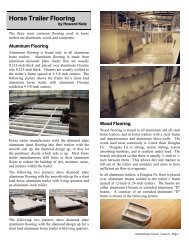CALCULATING PI - Mathemechanix.org
CALCULATING PI - Mathemechanix.org
CALCULATING PI - Mathemechanix.org
You also want an ePaper? Increase the reach of your titles
YUMPU automatically turns print PDFs into web optimized ePapers that Google loves.
figure in a half circle (or 12 for a full circle).The bases of the 12 triangles (no longerequilateral) will be closer to the adjacentcircle arc than are those for the firstestimate. The derivation need consider onlyone of the 6 triangles of equal size.Start by bisecting the line AC with lineOB which is found by bisecting the angleAOC to give two small angles q. Draw thebase of the resulting isosceles triangle asline AB. It is the length of this that we wantto compute. Once the length of AB has beendetermined, the second estimate for pi willbe 6 times AB for the half circle.After finding AB, repeat the process bybisecting AB with a new element that givesa third estimate for pi upon multiplying it by12 for the half circle. And so on. We want aformula that can be used repeatedly.Consider triangles ODA and OBE. Theseare both right triangles that share the smallangle q and have the same hypotenuselength. They are the same except fororientation. ThusBE = AD = AC/2 where AC/2=0.5 forthe first step in the process.Next find the length of OE using thePythagorean Theorem asOE 2 =OB 2 –BE 2 =1–BE 2 =1–(AC/2) 2Find EA asEA = 1 – OE = 1 – (1 – (AC/2) 2 ) 1/2EA 2 =1–2*(1–(AC/2) 2 ) 1/2 +1–(AC/2) 2Next, observe thatAB 2 =EA 2 +BE 2 =EA 2 +(AC/2) 2which results in the general formulaAB = (2*(1–(1–(AC/2) 2 ) 1/2 ) 1/2We can now use the value of AB for a newcalculation for segment length.We have started with AC/2 to find AB.We can then use this value as a new form ofAC. This is a cyclic process where wecalculate AC/2 and then rename this variableto get the next value of pi. Why not showrepetitiveness from the outset? Let AC=Sand find a new value for S asS = (2*(1 – (1 – (S/2) 2 ) 1/2 ) 1/2Let us work out the first few values for pias the computed value for S times thenumber of segments. We have the first valuefor S as 1 which becomes pi0 uponmultiplying it by 3. The next value hasS/2=0.5 in the basic equation. Find the newvalue of S as 0.517638. For six segments,the result is pi1=3.1058286. The next valuestarts with S/2=0.517638/2. The resultingcalculation for S gives S=0.2610523 foreach of 12 segments. Multiply by 12 to getpi2=3.1326286. Continue in this manner.Using a standard simple calculator, the errorremains small up to pi5 with a value ofS=0.0327257. Multiply by 96 segments toget pi5=3.141675.Accuracy is about one part in 30,000using a standard 8 digit calculator and tendsto become inaccurate for pi6 and beyond.Use a 10 digit pocket calculator for moreaccuracy. Or use a computer with “TrueBasic” as shown. You should be able toidentify steps with the calculator. Accuracyat pi11 is one part out of thirty million!.PROGRAM IN TRUE BASIC:LET P=3LET S=1PRINT 0,3,PFOR N=1 TO 15LET S=(2*(1-(1-(S/2)^2)^0.5)^0.5LET Q=3*2^NLET P=Q*SPRINT N;Q,PNEXT NENDN Q P____0 3 31 6 3.10582852 12 3.13262863 24 3.13935024 48 3.1410325 96 3.14145256 192 3.14155767 384 3.14158398 768 3.14159059 1538 3.141592110 3072 3.141592511 6144 3.1415926Stop at N=11. No change thereafter dueto the limited number of decimal places.Page 52




